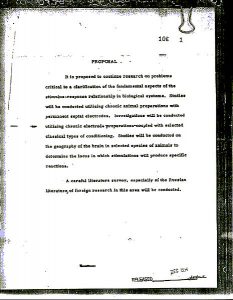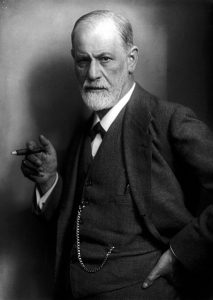Psychological experiments are experiments designed to further our knowledge of the human mind. Experimental psychologists will use both human and animal subjects to study many areas of psychology. Some psychological experiments are done with total disregard for the subjects and end up causing permanent psychological or even physical damage to the participants.

The Milgram Experiment

Copyright Fred the Oyster / (CC BY-SA 4.0)
Psychologist Stanley Milgram ran a series of psychological experiments on the obedience to authority figures that human beings display, the test resulted in some shocking, and horrifying revelations about the human mind. The test had three participants, two were in one room, and one in the other. There was an experimenter, and a tester in one room, in the room next to them was the learner who they couldn’t see. The experimenter would order the tester to ask the learner a question, and if the learner got the question wrong the tester must administer a harmful electric shock. The shocks increased in power, and the tester could even hear him scream. The learner was actually an actor who was in on it, but the tester had no idea. Sometimes the tester would protest and ask if he should stop giving him shocks, but would almost always carry on when the experimenter told him to continue. The test revealed that a scarily high proportion of people were willing to keep shocking him even when it was clearly causing serious injury or distress.

Asch Conformity Experiments

Copyright Fred the Oyster / (CC BY-SA 4.0)
Solomon Asch performed a series of psychological experiments in order to see whether people would conform to what the group thought even when the group was blatantly wrong. He put together a group of people and gave them the task of matching lengths. The answers were always obvious, but all the group members except one were actors. These actors were ordered to give the correct answer the first two times, but then all purposely give the same wrong answer the third time. The aim of this was to see if people would conform to the give the wrong answer. Surprisingly the majority of people would actually conform and give the wrong answer.

Harlow’s Monkey Experiments
American Psychologist Harry Harlow did fascinating research into the effects of maternal separation, dependency needs, and social isolation on Rhesus monkeys, in a series of controversial psychological experiments. Harlow took monkeys away from their biological mothers and gave them two new mothers instead. One was a cloth mother who did nothing, and the other was a wire mother who would feed the monkeys. Harlow found the monkeys had a closer relationship with the cloth mother, and spent most their time with that one, he also noted them when the monkeys were scared they would run to the cloth mother instead of the wire one.

Robbers Cave Experiment
Muzafer Sherif put on an experiment over a period of three weeks in a large 200-acre summer camp in Robbers Cave State Park, Oklahoma. He took 22 boys aged 11 to 12 who had never met each other before, and split them into two groups. The experiment was split into two stages, the in group formation stage, when they were split into two groups, and weren’t aware the other groups existence. Then came the friction stage, when the two groups engaged in competition with each other in games. These games caused a lot of tension between the groups which, and the score was always supposed to be close to create friction between the two groups. The last stage was the integration stage, in this stage the groups had to work together in order to achieve a common goal and this reduced the friction between the two.

Jane Elliot

Jane Elliot was an elementary school teacher who became famous for putting on a controversial experiment in her class. She divided her class in two, on the basis of eye colour. One side had brown eyes, and the other had blue. She then convinced the students that scientific research had revealed that the blue eyed students were superior to the brown eyed students. She then gave all the blue eyed students special privileges. The blue eyed children were given more food, more time at recess, and encouraged to only play with blue eyed children. The brown eyed children were treated cruelly, they couldn’t drink from the same water fountain as the blue eyed children, they were forced to sit at the back of the class, and all them had a brown collar placed on them by the blue eyed children to signify they were unequal. Later on the positions were reversed, and the brown eyed children were told they were superior, and the blue eyed children were treated cruelly.

The Monster Study

The monster study was a stuttering experiment conducted on 22 orphaned children in Iowa. The children were split into two groups, a positive feedback group, and a negative feedback group. The positive group was praised for the fluency of their speech, and the other group was harshly criticised for their mistakes. The negative feedback had horrific results on the children, some of them received psychological problems that haunted them for the rest of their lives. The study was conducted by Wendell Johnson who eventually realised how horrific his experiment was and tried to keep it a secret to protect his reputation.

Learned Helplessness

Three groups of dogs were put in harnesses and administered painful electric shocks. Group one were put in the harnesses for a period of time and then released, members of group two were given random electric shocks that could be stopped by the dogs pulling a lever. Dogs in group three were paired up with dogs in group two. Whenever a group two dog was given a shock, it would also shock the group three dog. The difference was that the group three dog had no way of stopping the shocks. Group three dogs would stop being shocked whenever the group two dog pulled his lever. To the group three dogs the shocks appeared to start and stop randomly. It eventually gave up trying to stop the shocks and entered a state of learned helplessness. The group three dogs began to show symptoms of depression, and it’s believed by some that learned helplessness is one of the man causes of depression.

Project MKUltra

Project MKUltra was a mind control program put on by the CIA. The CIA experimented on it’s own citizens to try and develop a new drug to help with torture and interrogations. They would use this drug to weaken the subjects mind in order to force them to confess through mind control. The CIA’s justification for this project was that they feared other countries may already have the technology, and be perfectly willing to use it. The program engaged in many illegal activities and is seen as one of the most unethical psychological experiments in American history.

Homosexual Aversion Therapy

In the 1950’s and 1960’s, aversion therapy was used to try and cure gay men of what was believed to be a mental illness at the time. It involved showing gay men pictures of naked men, and then electrocuting and drugging them in order to make them vomit. It was supposed to make them associate naked men with pain. When the pain became unbearable they were shown naked pictures of women as relief, or taken out on dates with young nurses.

Gua The Human Chimp
Gua was baby chimpanzee raised by two scientists as if she were a human baby. Luella and Winthrop Kellogg raised the chimpanzee as well as their real son as if they were twins. They wanted to see if the monkey would learn to act as human, by picking up our mannerisms, and maybe even learning to speak. The experiment went well at first, the chimp managed to walk on two legs, and even learnt to use a spoon when eating. Chimps mature faster than humans and it even started to learn things more quickly then the human and appeared to be smarter. However the experiment backfired eventually, instead of the chimp becoming more human, the human child began to act like a chimp. He didn’t learn a lot of words and actually started making chimp noises when communicating.

